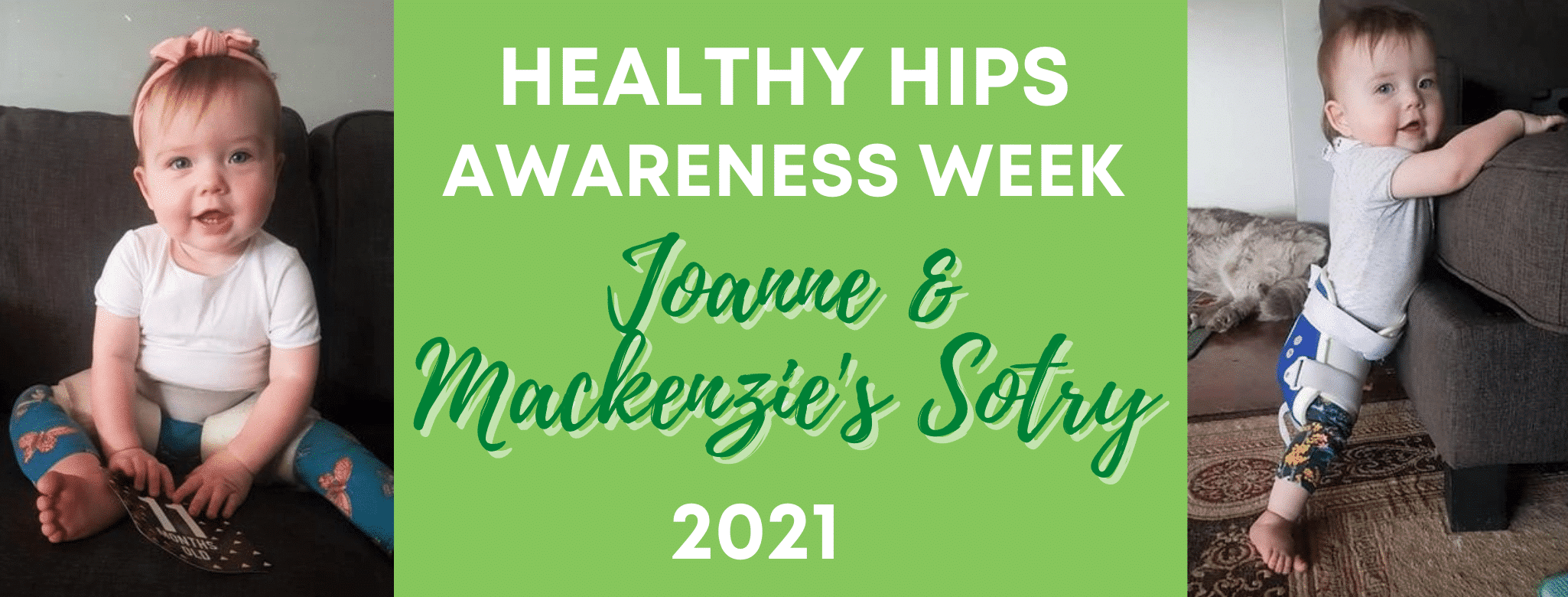
Joanne & Mackenzie’s story
Healthy Hips Awareness Week 2021
 Jo, hubby Josh, son Lincoln, 3 years, and there two huskies were super excited to meet the newest edition who was due on April 8. With COVID ramping up Jo was understandably nervous. Jo had spent her whole pregnancy saying that bub could come any day except April fool’s day… and Miss Mackenzie made her appearance at 8pm on April fools day.
Jo, hubby Josh, son Lincoln, 3 years, and there two huskies were super excited to meet the newest edition who was due on April 8. With COVID ramping up Jo was understandably nervous. Jo had spent her whole pregnancy saying that bub could come any day except April fool’s day… and Miss Mackenzie made her appearance at 8pm on April fools day.
Determined, happy and cheeky, Little Miss M brought so much love to their family.
The following are Jo’s words in normal text, describing a little bit of their journey from diagnosis to now. The italics are comments from myself, a paediatric physio, for more information.
in the beginning…
Everything started off as it normally would. We actually didn’t realise there was anything wrong and Miss M. She didn’t have any of the common risk indicators for hip dysplasia. After it was mentioned there could be something we realised that her legs did look a little crooked.
The Child Health Nurse (CHN) noticed uneven thigh creases at our 4 month check up. The GP wasn’t super interested when I first mentioned it so I am glad the CHN had given me some paperwork for the GP.
Uneven thigh creases is one sign of Hip Dysplasia, however they can also be present in children with no hip concerns. Advocating for your child is so important and having appointment summaries, findings or recommendations written down is particularly helpful. In those moments it is difficult to remember everything and written paperwork helps health professionals communicate effectively and make better decisions.
The GP then referred us for an ultrasound and an x-ray.
Between 4 – 6 months a baby’s hip joint changes from more cartilage to more bone. Ultrasound is fantastic to look at cartilage and x-ray for bone. However the timing can be slightly different for each baby, and so both of these investigations could add important information.
The results came back and the GP wasn’t too sure how to interpret them so he referred us to a paediatric orthopaedic surgeon.
The “what a hip should look like” changes rapidly as a baby grows and a paediatric orthopaedic surgeon had specialist knowledge at looking at the hip and its shape, not just the numbers in the report.
We chose to go privately at first as it meant the appointment would be sooner and by this time Miss M was nearly 6 months. However, we are lucky that our orthopaedic surgeon also works at our children’s hospital and we have attended appointments there since.
How did you feel?
It is an overwhelming thing to be told.
I went through a bit of a grieving process about what I had imagined vs what was going to be reality.
I ended up reminding myself that it was better to do it now, she wont remember, than for her to struggle later on.
Early diagnosis is important, as in the first year of life, when the hip socket is forming and shaping, is time where bracing is most effective.
How did things change after Miss M was fitted with the brace?
It definitely took a while to adjust to having the brace…for everyone.
Josh and I as parents were worried about whether we were doing the straps up properly, if the tightness was right and we spent a few days alternating who held miss M while we ate because she didn’t fit in our highchair. We were lucky that the pram we already had was suitable with the addition of a rolled towel.
Miss M has never been a fan of the brace, but the first few weeks were an adjustment period. Sleep for the first week was horrible and we ended up doing lots of cuddles, contact naps & panadol. Once we got through that we just rolled with it and adapted things so they worked for her.
When we first put Miss M in the brace I felt like there was so much to learn. Most of the information we found ourselves through Facebook groups, the Healthy Hips Australia Website, Google and the lovely people that fitted our brace.
The orthopaedic team was lovely and answered all our questions on the day which was great but it’s hard to ask the right questions about a subject you’re not very familiar with.
It would have been great to have a follow up appointment 2 weeks later to answer all my new questions and figure out what was normal now.
What / who did you find helpful?
The Healthy Hips Australia website had brochures that were incredibly helpful. The Facebook group I joined was also great for information and also for the sense of belonging to a community of people that were going through similar experiences. Nicole, (@nicole_kidsphysio), you have been fabulous as well, for ideas to try and for help with adapting those ideas to suit a bub in a hip brace
What are your top DDH hacks?
- The Kmart camping high chair/portable booster seat was fabulous! We ended up upgrading to the Aldi wooden high chair after our first review when we got told we’d be in the brace for a bit longer
- A rolled blanket under the legs while sleeping (In the brace bub cannot lay flat)
- Bonds wonderbodies suits, leggings & wondersuits were fabulous for summer. Really lightweight so miss M didn’t overheat because they need a bodysuit & long legs under the brace to avoid rubbing from the straps and foam
- You can fit a rhino babe in a trolley seat – they just take up the whole thing
What is your advice for other parents & caregivers embarking on this journey?
Hip dysplasia is a lot more common than you would think. While you’re allowed to feel cheated for the plan you had in your head, it’s so much better to go through the treatment early and when bub probably won’t remember it. The rhino kids are super adaptable as well. During the last 6 months miss M has been in a rhino brace 23 hours a day and has managed to learn to roll, crawl, sit unaided, pull up to stand and cruise furniture.
Were you worried about Miss M’s motor development?
Her ortho originally said milestone wise the only thing the rhino would hold her back on was walking So I figured everything else would be ok for her to try but really just tried to follow her lead. Sometimes I’d try things a bit too quickly for her (sitting etc when her mother’s group friends were doing it) and she was uncomfortable or didn’t seem happy so we would wait a bit longer and try again later on. I basically had to throw the “milestone by this age” idea out the window & just make sure we were doing things at her pace.
At her last check up one of the ortho’s came out and saw her cruising on the furniture in the brace. He got so excited he went back up the hallway & called out to someone “Hey want to know why the rhino is referred to as The Cruiser?? Come check this out” so then they were both watching her. It was quite funny but made us feel proud.
Check in with your orthopaedic surgeon and team, as recommendations on what you can do might differ, due to severity, brace type etc. For example, sometimes parents are told to avoid sidelying.
Miss M is now only in the brace for nights and naps and she has just started to walk!
Thank you Jo & Miss Mackenzie for sharing your story to help support other parents and families going through their own DDH journey.
I have attached a list of resources below that may also be helpful.
Healthy Hips Australia Website – Resources for Parents & Caregivers
Other Families Stories – Hip Dysplasia International









